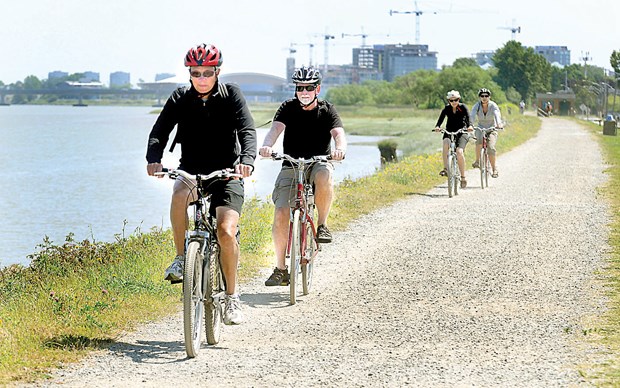It can be hard enough for governments to budget beyond the next election year. But try getting them to consider making financial commitments through the next century.
That’s part of the task the Richmond Chamber of Commerce has laid out after releasing its report Tuesday on the economic importance of the Lower Fraser River.
In it, the 73-page document that was compiled with the help of 12 other chambers and boards from Richmond to Hope, calls for a plan of action to keep anticipated, climate change-produced flood waters at bay into the year 2100, which is estimated to cost around $9 billion.
While that figure may get politicians choking on their nomination papers, the dollar amount is not the crux of the report — getting governments to move in the direction of flood management on the Fraser River is, said Matt Pitcairn, the chamber’s manager of communication and policy, who co-authored the report.
“We’re not asking for a specific dollar amount or specific action. We’re calling on senior levels of government to come together with major stakeholders and put a long-term, holistic management plan in place,” Pitcairn said.
And the current seems to be starting to flow on the issue as the The Fraser Basin Council also announced Tuesday its Flood Management Strategy to strengthen flood management policies and practices, as well as flood protection works across the Lower Mainland.
“This flood management strategy reflects a serious, unprecedented commitment by the federal government, the Province of BC, 25 Lower Mainland local governments, and other public and private sector organizations to work together on flood protection measures that will safeguard the region as a whole,” said Colin Hansen, chair of the Fraser Basin Council, in a press release.
The strategy focuses on Fraser River freshet flooding — as a result of spring snowmelt — and coastal flooding, resulting from storm surge in the winter months.
According to the chamber’s report, among the most serious threats is large scale flooding that could come sooner than later, as scientists have predicted a one in three chance of record flooding along the Lower Fraser River within the next 50 years.
“Without major protective improvements, the cost in flood relief and in loss of revenue to all levels of government would be immense, greatly surpassing the cost of major flood events in other parts of Canada in recent years,” the study states.
Increasing the dire warning is the impact of climate change that could hasten the 100-plus year flood catastrophes to about four to 10 year intervals.
The study predicts that due to shifting climate patterns, sea levels at the mouth of the Fraser River will have risen 1.2 metres by the year 2100.
To counter that, an estimated $9.5 billion needs to be spent, with $8.8 billion of that going to protection of the tidal portions of the Lower Fraser River.
“If you do the math, we’re talking roughly a $100 million investment a year for the next century to meet the anticipated sea level rise. So, we’re talking about a major commitment,” Pitcairn said. “But we’re not asking for that to happen tomorrow, but let’s start to put a long-term plan in place today.”
The long-term future of the Fraser River has been on the chamber’s agenda for some time, said chamber chair Gerard Edwards, adding one way to bring river-related issues forward is to raise its profile nationally, something the report does when comparing it to the St. Lawrence Seaway.
In 2011, 28.7 million tonnes of Canadian cargo was carried on the Montreal-Lake Ontario section of the Seaway. In comparison, 26.9 million tonnes of cargo is handled in the Fraser River part of Port Metro Vancouver, according to the report.
As far as economic impact, the St. Lawrence was responsible for 63,041 jobs, with 52,900 from the Fraser.
“The decision was to create national awareness, not just about the problems of the Fraser, but the impact the river has on us economically, and not just for Richmond, but all the communities along it, for B.C. and the rest of Canada,” Edwards said.
But it’s not just flooding in general that is a threat to agriculture in the region, which according to the report accounts for more than 62 per cent of B.C.’s farm sales — an estimated $1.6 billion annually.
“Considering the Fraser Valley Regional District (FVRD) and Metro Vancouver’s farms generate more than 62 per cent of the province’s gross farm receipts (about $1.6 billion annually), the impact of severe flooding would be significant,” the report states.
While long-term flood planning is commendable, local environmentalist and former city council candidate Michael Wolfe said the action being considered has less to do with the environmental protection of communities along the river and more about furthering the industrialization of the Lower Fraser River.
“It’s great to have long-term thinking behind economic strategies, where for the most part it has been about short-term gain and benefits,” Wolfe said.
But he added that all the warnings about future floods and dealing with them is a way of “enabling industrialization,” while the chamber of commerce has helped facilitate the process by, “giving it an economic purpose to be involved in restructuring the use of the Lower Fraser River through Richmond and Delta.”



